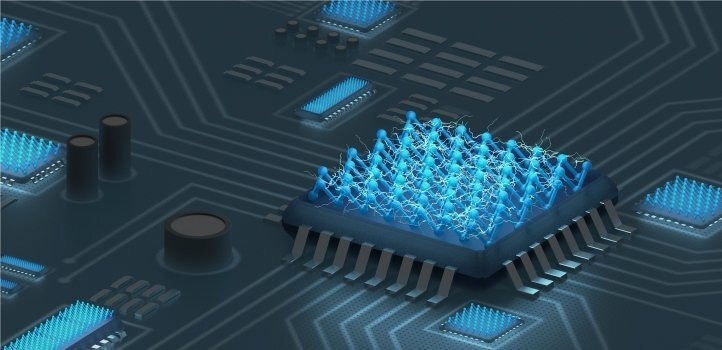Ultrathin phosphorus semiconductors that become metallic when stacked can tackle resistance issues and boost transistor performance.
 Illustration of field effect transistors based on the recently discovered blue form of ultrathin phosphorous. Image Credit: KAUST; Heno Hwang
Illustration of field effect transistors based on the recently discovered blue form of ultrathin phosphorous. Image Credit: KAUST; Heno Hwang
A newly discovered blue form of ultrathin phosphorus—with electronic properties that can be tuned to enhance the injection of charge carriers (negatively and positively charged) into transistors—are set to push next-generation electronic devices forward.
Two-dimensional semiconductors, such as graphene and transition metal dichalcogenides, are expected to drive the miniaturization of electronic devices by providing ultrathin active channels for charge-carrier transport in field effect transistors (FETs).
Essential to modern circuitry, FETs are used to influence the flow of current through their channels by applied voltage and behave like electronically controlled switches or amplifiers. However, electric resistance arises at the interfaces between the semiconductor channels and metal electrodes. This limits the charge injection into the devices and prevents the FETs from reaching their full potential.
"Reducing this contact resistance will improve the current delivery capability and improve the performance of the FETs, which will pave the way for future microelectronics," says Shubham Tyagi, a Ph.D. student in Udo Schwingenschlögl's group.
Now, Schwingenschlögl's team has designed a junction-free FET using the recently discovered two-dimensional blue phosphorene as the single electroactive material. Blue phosphorene itself is a semiconductor but becomes a metal when stacked into a bilayer.
"The ability of blue phosphorene to change its electronic properties based on stacking is crucial for our device," Tyagi says. "Once we obtained a crystal orientation that delivers high carrier mobility through the channel, we were confident that we would achieve positive results because the contact resistance is addressed by the junction-free design," he adds.
At the heart of the junction-free device is a blue phosphorene monolayer that, acting as the channel, lies between two metallic blue phosphorene bilayers that work as electrodes. The channel and electrodes consist of the same material, which results in a continuous structure, therefore reducing the resistance.
Using computer simulations, the researchers investigated the quantum transport in the proposed FET design for two different directions: armchair and zigzag. In both configurations, the FET effectively mediated electron transfer between channel and electrodes while meeting switching and amplification criteria. It outperformed devices using other two-dimensional materials, such as black phosphorene and monolayer molybdenum disulfide.
"In the future, we want to address different ways of improving the FET performance," Tyagi says.
The researchers are working to reduce the current leakage between transistor gate and electrodes using van der Waals materials, which consist of sheets held together through weak interactions. They are also exploring ways to extend their ideas to magnetic materials to develop spintronic devices.
The study is published in the journal npj 2D Materials and Applications.